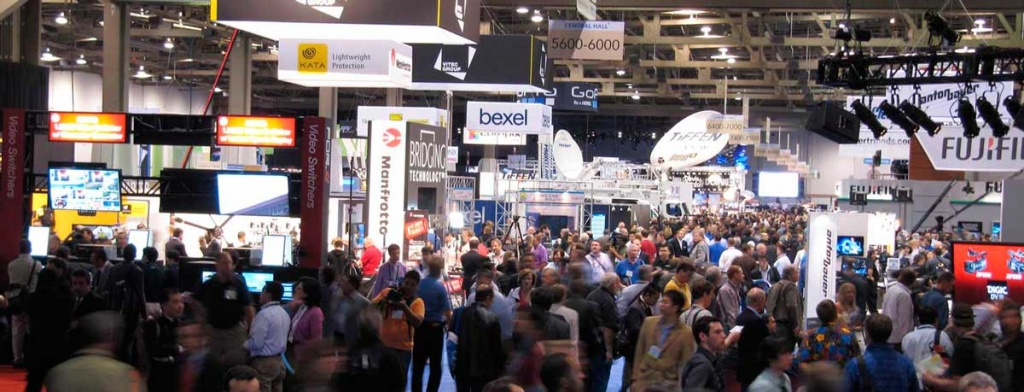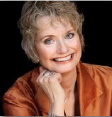The NAB 100th Anniversary edition Highlight the Broadcast Market for Satellite
by Elisabeth Tweedie
 Las Vegas, Nevada, April 27, 2023--This year marked the centennial of the NAB show. From its humble beginnings in 1923 with just 23 attendees, who got together in New York to discuss the future of broadcasting – and at that time broadcasting was only radio - the NAB show has grown dramatically. It moved to its (so far) permanent home in Las Vegas in 1988. Previously, the show took place at various venues in the US including Washington DC, Chicago, Los Angeles, Atlantic City and Cleveland. From 1978-88 it rotated between Las Vegas and Dallas before “settling” in Las Vegas. This year, the centennial, there were 65,013 registered attendees from 166 countries. The highest ever attendance was recorded in 2008 with over 100,000 attendees.
Las Vegas, Nevada, April 27, 2023--This year marked the centennial of the NAB show. From its humble beginnings in 1923 with just 23 attendees, who got together in New York to discuss the future of broadcasting – and at that time broadcasting was only radio - the NAB show has grown dramatically. It moved to its (so far) permanent home in Las Vegas in 1988. Previously, the show took place at various venues in the US including Washington DC, Chicago, Los Angeles, Atlantic City and Cleveland. From 1978-88 it rotated between Las Vegas and Dallas before “settling” in Las Vegas. This year, the centennial, there were 65,013 registered attendees from 166 countries. The highest ever attendance was recorded in 2008 with over 100,000 attendees.
To say that the industry has changed significantly in the last hundred years would be an understatement. In the words of Chris Brown, NAB, Vice President: “Think about how far the industry has come in that time, from a strictly audio medium to the introduction of moving images, to the dawn of film, TV, cable, satellite, streaming – and all the amazing technology that has driven those incredible advances. NAB has both been a reflection of those changes and a catalyst for changes to come.” In that context it is worth while remembering just how long some technologies take to become mainstream. Streaming was first introduced at NAB 18 years ago.
Once the exclusive purvey of Netflix and Amazon Prime, streaming is now one of the several delivery methods used by the majority of content providers. But the nature of streaming itself is also changing. This was evident by the amount of attention given to the subject both on the show floor and in the sessions. Streaming is no longer simply an Over-the-top (OTT) service, with a lower monthly subscription fee than cable or direct-to-home (DTH) services. It comes in multiple varieties including free advertising supported TV (FAST). The latter is rapidly growing in popularity, particularly in the US. This in itself is interesting, as essentially FAST looks pretty much like over-the-air linear broadcast television, i.e. the viewer has no control over the content and can’t fast-forward through the advertisements. So, is the industry going full-circle? Part of FAST’s rapid growth, may be attributed to inflation. Understandably, widespread rising prices have an impact on consumers’ discretionary spending so increasing the appeal of a free service. During one of the panels at NAB, the question of whether FAST had reached saturation point was discussed. There are now multiple FAST services, each offering hundreds of channels and Chris Knight, President and CEO, Gusto (a cooking themed FAST channel) said that he believed “there will be a culling of the herd, in the next two years.”
This move away from subscription video-on-demand (SVoD) was reflected in the annual IABM Breakfast Briefing, where it was pointed out that for the first time since its introduction in January 2020, subscriptions to Disney + fell in the first quarter of this year. In a similar vein, a recently released report from Digital TV Research, “Global OTT TV and Video Forecasts” report, showed that advertising supported video-on-demand (AvoD) will grow twice as fast as (SVoD) by 2028, to reach a revenue total of US$91 billion up from US$41 billion last year. To be clear, AVoD differs from FAST, as the viewers choose when and what they want to watch. However, all is not doom and gloom for the rest of the OTT segment, the same report indicated that overall OTT revenues would grow to US$235 billion in 2028, up from US$154 billion in 2022. Nevertheless, the major SVoD providers are doing what they can to cut costs. For example, it was reported at the end of last year that Netflix, is focusing on hiring junior rather than experienced staff, cutting real estate expenditure, and scaling back spending on cloud services and content. Earlier this year, Netflix cut subscription prices in over 30 countries, with some tiers being reduced by 50% according to a report in the Wall Street Journal.
During the show FCC Chairwoman Jessica Rosenworcel, announced a new public-private partnership initiative, known as “The Future of TV.” The goal is to identify a roadmap for an orderly transition to ATSC 3.0, colloquially referred to as “NextGen TV”, to make the transition as smooth as possible for consumers. The initiative will be led by the National Association of Broadcasters. Current over-the-air (OTA) broadcasting utilizes the Advanced Television Systems Committee’s (ATSC) version 1.0. ATSC 2.0 was never launched and its advances have been incorporated into ATSC 3.0. This standard is a fundamental leap for OTA free broadcasts. It will enable 4K, HDR, wide color gamut (WCG) and high frame rate (HFR), in other words it will elevate broadcast TV to the same quality level as the best OTT, cable and satellite services. According to NAB CEO, Curtis LeGeyt, over 60% of Americans are already in range of a NextGen TV signal. One of the major issues for consumers is that it will be necessary to acquire a new ATSC 3.0 compatible TV or set top box, which obviously imposes cost and accessibility challenges. It also has the potential to be delivered to mobile devices, that however will require the cooperation of the cellular industry, both operators and handset manufacturers.

As mentioned in my previous article about Satellite 2023, for the first time there were no conference sessions covering video. Similarly, at NAB, there were no sessions focused on satellite. Satellite has definitely been diminishing in visibility at NAB for the last few years, although the major operators and many of the ground segment providers still exhibit. Some of the smaller companies that I spoke to, commented that it had been a relatively quiet show for them and were questioning whether they would exhibit next year. Nevertheless, the segment was not ignored. ST Engineering iDirect’s MCX8000 Multi-Carrier Satellite Gateway won the Hardware Infrastructure Product of the Year award. This award recognizes the most significant and promising new products and technologies showcased by exhibitors at the show. The IABM briefing highlighted that total cost of ownership (TCO) continues to be the number one purchasing driver for media companies. The MCX8000 was designed with this in mind. It brings together high density and high reliability to deliver a future-proof system that combines video and IP multi-service capabilities. This enables broadcasters to cater for every type of broadcast scenario including OTT and direct-to-home (DTH).
The other big news for the satellite industry was the announcement by Intelsat that it had signed an exclusive satellite deal with PBS, the US public service broadcaster, to distribute its programming to 156 PBS affiliates covering 50 million prime time viewers, across the nation. “As America's largest public media enterprise, PBS trusts Intelsat to reliably deliver on their crucial mission of providing high-quality programming to their member stations across the continental United States," commented Pascale Fromont, Vice President and General Manager of Media for Intelsat. "With the addition of PBS to the Intelsat family, all major broadcasters in the U.S. are utilizing the Intelsat fleet for content delivery." The Intelsat Galaxy fleet serves 123 million TV households in North America. So, whilst satellite may have taken a back seat at this year’s show, this announcement coupled with ST Engineering iDirect’s award, proves that the industry is as relevant as ever for content producers.
------------------------------------
 Elisabeth Tweedie has over 20 years experience at the cutting edge of new communications entertainment technologies. She is the founder and President of Definitive Direction (www.definitivedirection.com), a consultancy that focuses on researching and evaluating the long-term potential for new ventures, initiating their development, and identifying and developing appropriate alliances. During her 10 years at Hughes Electronics, she worked on every acquisition and new business that the company considered during her time there. She can be reached at etweedie@definitivedirection.com
Elisabeth Tweedie has over 20 years experience at the cutting edge of new communications entertainment technologies. She is the founder and President of Definitive Direction (www.definitivedirection.com), a consultancy that focuses on researching and evaluating the long-term potential for new ventures, initiating their development, and identifying and developing appropriate alliances. During her 10 years at Hughes Electronics, she worked on every acquisition and new business that the company considered during her time there. She can be reached at etweedie@definitivedirection.com





